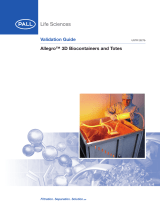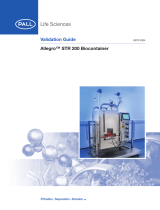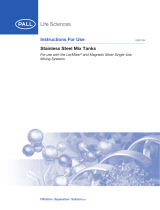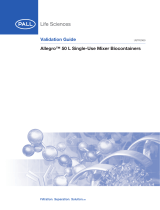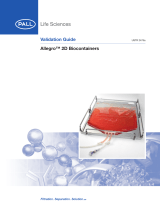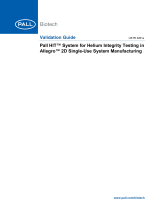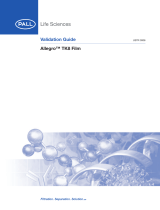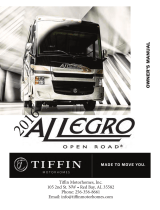Page is loading ...

USD 3055
Instructions for Use
Allegro™ 3D Biocontainers and Allegro Totes
1000 L, 2000 L and 3000 L

2
Table of Contents
1. Introduction..................................................................................................................................................3
2. Warning ........................................................................................................................................................3
3. Receipt of Equipment..................................................................................................................................3
4. Installation and Operation ...........................................................................................................................3
4.1 Preparation and installation of the Allegro base and extension module ....................................................4
4.2 Preparation and installation of the hoist ..................................................................................................7
4.3 Installation of the Allegro biocontainer/system........................................................................................10
4.4 Filling the Allegro biocontainer/system ..................................................................................................11
4.5 Draining the Allegro biocontainer ..........................................................................................................13
4.5.1 From the bottom (1000 L, 2000 L, and 3000 L) ..........................................................................13
4.5.2 From the Top (1000 L only) ..........................................................................................................13
4.6 Removing Allegro 3D biocontainer from the Allegro tote ........................................................................13
5. Allegro Biocontainer Replacement ...........................................................................................................13
6. Troubleshooting Guide ..............................................................................................................................13
7. Scientific and Laboratory Services...........................................................................................................14
8. Warranty .....................................................................................................................................................14

1. Introduction
The following procedure is provided for the installation of Pall single-use systems incorporating Allegro 3D
biocontainers with capacities of 1000 L, 2000 L and 3000 L in the corresponding stainless steel Allegro
totes. Pall Allegro 3D biocontainers must be used in accordance of this manual. The instructions contained
in the biocontainer product documentation should be read thoroughly because they contain valuable
information gained by extensive experience. It is very important that all instructions in this document
are carefully followed and, where appropriate, they should be incorporated into the user’s standard operating
procedures. If some of the procedures do not suit your needs, please consult Pall or your local distributor
before finalizing your system. Use of this product in a manner other than in accordance with Pall’s current
recommendations may lead to injury or product loss. Pall cannot accept liability for such injury or loss.
2. Considerations for Care and Use of Allegro Biocontainers
Warning: Operation outside the parameters defined in the product data sheet or with fluids incompatible
with construction materials may cause personal injury and result in damage to the equipment. Incompatible
fluids are fluids which chemically attack, soften, stress, attack or adversely affect the materials of
construction. The system should never attempt to be transported or moved when filled. Please refer
to Pall for exact limits and refer to USTR2527: Allegro 3D biocontainer validation guide. For more
information please contact [email protected].
Warning: The use of solutions containing low molecular weight alcohol, especially isopropyl alcohol, to
decontaminate the exterior of the Allegro biocontainers may, in circumstances where significant stress
(repetitive bending and twisting) is applied during use, cause damage to the molded LDPE inlet and
outlet ports. The flexible LDPE film of the Allegro biocontainers is not affected.
3. Receipt of Equipment
Allegro 3D biocontainers are usually provided as part of an Allegro system that has been sterilized by
gamma irradiation by request.
1. Store the Allegro 3D biocontainer/system in clean, dry conditions between 0 and 30 °C without
exposure to radiation sources like direct sunlight and, wherever practical, in the packaging as delivered.
2. Do not remove from packaging until just before use.
3. Check that the packaging is undamaged prior to use.
Caution: Avoid the use of sharp blades or pointed instruments that could damage the Allegro 3D
biocontainers and other system components, and potentially damage the filter (if included). Do not open
the bag by forcing any of the system components through the sealed end because this can generate
particulate contaminants.
4. Ensure that the Allegro 3D biocontainer system selected is suitable for the application.
5. In addition to the part number, each biocontainer is identified by a unique lot number.
4. Installation and Operation
The hardware to support the 1000 L, 2000 L and 3000 L Allegro biocontainer systems are made of
a stand, a base module that supports the 1000 L biocontainer, and available extension modules to
accommodate the 2000 L and 3000 L Allegro biocontainer systems respectively, depending on the
configuration (refer to Figure 1). Both the base module and the extension modules consist of passivated
304 SS. A hoist is necessary extend the top of the Allegro biocontainer for the 2000 L and 3000 L sizes.
It is not needed with the 1000 L base module.
Note: A crane or fork lift should be onsite to stack the extension modules.
www.pall.com/biopharm 3

4
Figure 1
Base module and extension modules
Table 1
General hardware assembly overview
Item Part number Dimensions Weight
Base Stand LGR3000STAND 1066 mm x 1260 mm x 600 mm high 70 Kg
Base Module LGR3000BASE 1066 mm x 1260 mm x 1406 mm high 230 Kg
Extension Module LGR3000EXT 1066 mm x 1260 mm x 1000 mm high 160 Kg
Lifting Hoist LGR3000HOIST 405 mm x 225 mm high 10 Kg
4.1 Preparation and installation of the Allegro base and extension module
To prepare the tote for use:
1. Check that the area designated for use is clear and can accommodate the hardware system
being installed. Ensure that the surface area is flat, level, and strong enough to bear the
weight of the tote when full. If required, prepare studs for screwing the feet down. Please
refer to Table 1 for clearance.
2. Using a forklift, position the stand on the level area intended for use (Figure 2).
Figure 2
Hardware stand
Biocontainer Lifting Hoist
3000 L Extension Module
2000 L Extension Module
Base Module 1000 L
Base stand

3. Next using the forklift, lift the base module and position it over the stand (Figure 3).
Figure 3
Base module lifted directly over stand using a forklift
4. Ensure the base modules feet are completely aligned with the holes on the stand frame so the
bolts can be inserted (Figure 4).
Figure 4
Stand frame alignment with base module
5. Once the bolts on the base module are aligned with the holes on the stand, slowly lower the
fork lift to drop the bolts into place (Figure 5).
Figure 5
Bolts inserted into four holes
www.pall.com/biopharm 5

6
6. Secure nut and washer using an adjustable wrench to fasten the entire stand to the base
module (Figure 6).
Figure 6
Secure bolts with nuts and washers
7. Attach an extension module(s) using a fork lift or hoist on the top of the base module as
follows: NOTE: Extension module is not used for the 1000 L
- Attach the two lifting plates to the top of the extension module by dropping one end over
a position pin and aligning the other side with a bolt into the hole. Fasten down with a
washer and nut and the adjustable wrench (Figure 7). (The lifting plates will be used to
lift the extension module)
Figure 7
Lifting plate secured to top of extension module
- Attach crane or hoist carabiner to the two locking plate eyes (Figure 8).
Figure 8
Crane secured to each lifting plate eye with a chain
Lifting plate

- Lift the extension module over the base module so that the four locating pins align with the
four corner holes. Then lower the extension module on top of the base module so that the
four corner locating pins insert into the holes on the base module (Figure 9).
Figure 9
Four corner locating pins aligned with four corner holes
Next fasten the ten bolts with nuts with top and bottom washers to secure the base module to
the extension module (Figure 10).
Figure 10
Secure ten bolts with nuts and washers
4.2 Preparation and installation of the hoist
1. Attach the hoist bracket to the top of the extension module by placing each side of the
bracket frame holes into the positioning pins. Fasten the other hole on the bracket feet using
a bolt with nut and washer (Figure 11). This is installed in the same manner as the lifting plate
mentioned above.
Figure 11
Bracket frame secured. Note: Crossbar will not be attached at this step yet.
www.pall.com/biopharm 7

8
2. Feed the stainless cable through the pulley on the top corner of the extension module and
pull the cable toward the ground until the carabiner rests on the pulley (Figure 12).
Figure 12
Cable pulled through side pulley
3. Slide the other end of the stainless cable through the small hole located inside the friction
wheel. Connect the cable lock to the cable by sliding it over the cable and fastening the two
flat head screws secure it to the cable. This will prevent the cable from disconnecting from the
friction wheel. (Figure 13)
Figure 13
Cable fastened by cable lock.
4. Using a ladder, pull the end of cable that has carabiner through large center pulley on hoist
frame directly above extension module
5. Feed cable down from the center pulley until the stainless cable with carabiner attached is at
the inside bottom of the base module. Open each of the doors on the base module by pulling
the black locking pin toward you and turning the latch to the side (Figure 14).
Figure 14
Doors being opened

6. Connect the carabiner on to the crossframe to the cable that has been lowered (Figure 15).
Figure 15
Carabiner attached to crossframe
7. To extend the cross frame arms, turn the knob on each arm and slide each arm to the four
tote corners. The cross frame arms should be adjusted so they are 15 – 20 mm from the tote
inner corners (Figure 16).
Figure 16
Knob turned to extend crossframe arm
8. Using the friction wheel, raise the crossbar inside the tote to prepare for biocontainer
installation (Figure 17).
Figure 17
Operator raising crossframe
www.pall.com/biopharm 9

10
9. Prior to Allegro biocontainer installation, the lift pin needs to be released to unlock the port
plate clamp (Figure 18).
Figure 18
Lifting pin being released
10. The swivel locking plate is used to secure and unsecure the ports of the Allegro biocontainer
and needs to be opened to install the Allegro biocontainer. (Figure 19).
Figure 19
Swivel door opened
4.3 Installation of the Allegro biocontainer/system
1. Confirm that the selected Allegro 3D biocontainer/system is suited for the tote.
2. Inspect the Allegro biocontainer system packaging. Verify that it is free from damage that
might compromise the integrity of the system.
3. Remove the system from its packaging. Do not unfold the Allegro biocontainer.
4. Hold the Allegro 3D biocontainer with the port plate facing down (at the bottom) and closest
to the front (opening side) (Figure 20).
Figure 20
Unpackaged Allegro biocontainer inserted into tote
Note: Two operators are recommended to perform Allegro biocontainer installation

5. Install the Allegro 3D biocontainer into the base of the tote and ensure biocontainer is as level
as possible to the base of the tote. When laying flat, the ports of the biocontainer should align
with the tote grooves (Figure 21).
Note: The Allegro biocontainer label is located on the top of the system and needs to be facing
upward towards the user.
Figure 21
Ports aligned with grooves in base of the tote
6. Close all clamps on the outlet lines and ensure that the inlet lines are open on the biocontainer.
Secure the lower swivel door and replace locking pin. Attach the four hoist clips to the holes
four holes located at each corner of the top of the biocontainer. Ensure each clip fastens to
the corresponding hole so that the crossbar is holding the four connection points (Figure 22).
Figure 22
Four hoist clips connected to biocontainer holes
4.4 Filling the Allegro biocontainer/system
Once the biocontainer is secured into the base of the tote and aligned with four hoist connection
perform the following:
1. Check that the outlet lines are closed
2. Using the friction wheel, raise the biocontainer (Figure 23)
Figure 23
Raising the Allegro biocontainer using the friction wheel
www.pall.com/biopharm 11

12
3. The Allegro biocontainer should be raised so that the crossbar with the Allegro biocontainer
connected is near the top of the extension module (Figure 24).
Figure 24
Allegro bicontainer raised inside the tote
4. Open the filling line supply and begin to fill the system through the biocontainer inlet.
5. After adding about 15 liters, stop and make sure the biocontainer base is flat and reaches into
the corners of the tote.
6. Close the doors and monitor the filling process. Sight glasses are located on each module to
view the filling. (Figure 25)
Figure 25
System filled with sight glasses covered
Warning: Do not fill the biocontainer above its maximum volume specifications
7. As the filling is in progress, the operator MUST regularly raise the hoist to avoid folds developing.
Warning: Failure to raise the hoist during the filling process may result in a fold in the biocontainer
that can potentially cause uneven filling
Warning: Do not open the doors during filling operation.
Note: Allegro 1000 L 3D biocontainers can be filled from either the top or bottom ports. The
2000 L and 3000 L can only be filled from the bottom ports. The biocontainer will naturally move
during filling. When filling through the top ports for the 1000 L, position the tubing in the center
of the biocontainer, so it does not become snagged or pulled during the filling operation. Upon
completion of filling, close the filling line. Disconnect the filling line in accordance with the
requirements of the connection device and your own aseptic standard operating procedures

4.5 Draining the Allegro biocontainer
4.5.1 From the bottom (1000 L, 2000 L, and 3000 L)
1. Connect the dispensing line in accordance with the requirements of the connection
device and your own site aseptic procedures.
2. Open the clamp on the selected drain line.
3. Commence the draining operation. The biocontainer will collapse as the fluid is
drained. Using the friction wheel, lower the crossbar to the base of the tote during
the draining.
4. Once drainage is complete, close the clamp on the dispensing line.
5. Disconnect the dispensing line in accordance with the requirements of the connection
device and your own site aseptic procedures.
4.5.2 From the top (1000 L only)
Draining from the biocontainer is usually performed via the bottom port. Fluid can be
drained via the top ports if required. When emptying from the top, however, sufficient
tubing length on the top ports must be allowed to compensate for the collapse of the
biocontainer during emptying.
4.6 Removing Allegro 3D biocontainer from the Allegro tote
1. Drain the Allegro 3D biocontainer fully as noted above.
2. Close all clamps and disconnect the system completely.
3. Disconnect the crossbar from the biocontainer.
4. Open the locking port support plate and then slide the collapsed biocontainer directly
towards you.
5. Remove the Allegro biocontainer/system.
5. Allegro Biocontainer Replacement
Allegro 3D biocontainers/systems are designed for single-use and should be replaced in line with the
cGMP requirements of the process. Discard the Allegro 3D biocontainer/system in accordance with
local Health and Safety and Environmental procedures.
6. Troubleshooting Guide
Problem: Allegro biocontainer is not filling/draining.
Cause: Fluid supply may be restricted or closed. Tubing may be crimped or twisted.
Solution: Check fluid supply. Confirm that all clamps on the appropriate line are open and that the tubing
is not pinched or twisted. Ensure all connections on the appropriate line are fully activated.
Problem: The biocontainer does not open correctly during fill.
Cause: The biocontainer swivel door is not secure.
Solution: Ensure the swivel door is in position and secure. Check that the corners of the biocontainer
are aligned with each of the corners of the tote. Ensure the side panels are folded over the top face
of the biocontainer when installed. A 20 – 25 mm gap between the biocontainer and the edge of the
tote is acceptable.
Problem: Excessive creasing and folds are observed during filling of the biocontainer and excessive
pressure observed on the friction wheel.
Cause: The selected biocontainer may have been installed backwards with the label not above the
center port.
Solution: The biocontainer will have to be drained and repositioned.
www.pall.com/biopharm 13

7. Scientific and Laboratory Services
Pall operates a technical service to assist in the application of all of its products. This service is readily
available to you and we welcome your questions so that we can help. In addition, a full network of
technical representatives is available throughout the world.
8. Warranty
Pall warrants that the Allegro systems manufactured by Pall, when properly stored and installed, and
operated as per the specifications and design conditions stated in this document will be free from
defects in material and workmanship during their shelf life.
Pall liability under any warranty is limited solely to replacing, or issuing credit for the Allegro systems
that may become defective during the Warranty Period.
Appendix 1
Allegro biocontainer single-use standard systems
650-203T 1000 L cubic biocontainer for 3000 L tote, ½ in. ports (APST)
650-204A 1000 L cubic biocontainer for 3000 L tote, ½ in. ports (Advantaex)
650-203U 2000 L cubic biocontainer for 3000 L tote, 1½ in. ports (APST)
650-203V 3000 L cubic biocontainer for 3000 L tote, 1½ in. ports (APST)
Corporate Headquarters
Port Washington, NY, USA
+1.800.717.7255 toll free (USA)
+1.516.484.5400 phone
[email protected] e-mail
European Headquarters
Fribourg, Switzerland
+41 (0)26 350 53 00 phone
[email protected] e-mail
Asia-Pacific Headquarters
Singapore
+65 6389 6500 phone
[email protected] e-mail
International Offices
Pall Corporation has offices and plants throughout the world in locations such as: Argentina, Australia, Austria,
Belgium, Brazil, Canada, China, France, Germany, India, Indonesia, Ireland, Italy, Japan, Korea, Malaysia, Mexico,
the Netherlands, New Zealand, Norway, Poland, Puerto Rico, Russia, Singapore, South Africa, Spain, Sweden,
Switzerland, Taiwan, Thailand, the United Kingdom, the United States, and Venezuela. Distributors in all major
industrial areas of the world. To locate the Pall office or distributor nearest you, visit www.pall.com/contact.
The information provided in this literature was reviewed for accuracy at the time of publication. Product data may
be subject to change without notice. For current information consult your local Pall distributor or contact Pall directly.
© 2015, Pall Corporation. Pall, and Allegro are trademarks of Pall Corporation. ® indicates a trademark
registered in the USA and TM indicates a common law trademark. Filtration.Separation.Solution. is a service
mark of Pall Corporation.
4/15, PDF, GN15.6225 USD3055
Visit us on the Web at www.pall.com/allegro
E-mail us at [email protected]
/

